In the fall a gardener’s fancy lightly turns to thoughts of pruning (with apologies to Alfred, Lord Tennyson). In particular, people worry that pruning too late in the summer or early fall will stimulate plants to send out new growth, which is then damaged by freezing temperatures. Let’s dissect what actually happens when woody plants are pruned during this time.
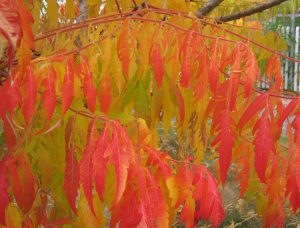
First, we need to separate temperate trees and shrubs from tropical and subtropical species. For the most part, the latter don’t become winter dormant: pruning them at any time means you will have regrowth as long as there are sufficient resources. If planted in more temperate zones, they will continue to grow until they are killed by freeze damage. Instead, we’ll look at temperate species and how they are adapted to surviving winter conditions.
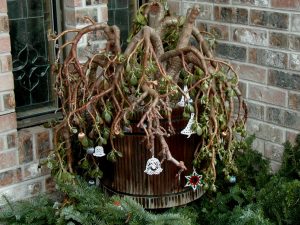
I wrote a couple of posts last year on cold hardiness (here and here), so I won’t repeat those discussions on how plants survive freezing. Instead, we’ll focus on the process of HOW plants enter winter dormancy and become cold hardy. It’s a two-step process that depends on two different environmental factors: one that never changes from year to year, and one that certainly can.
The first step to dormancy is initiated right after the summer solstice. Plants are exquisitely adapted to changes in the light-to-dark ratio, and days begin shortening after the summer solstice. The changes that occur are largely biochemical, but you can also see some changes in plants themselves. Many trees and shrubs slow their growth during this time so that fewer young leaves and shoots are produced. Instead, resources are put into the existing foliage, or flowers for summer bloomers. Excess resources are routed to woody parts of the plant for storage.
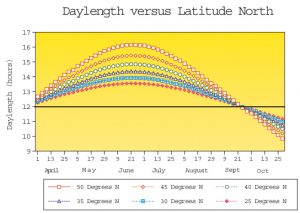
From a practical standpoint, this means that when you prune trees and shrubs where growth has stopped, you will NOT get regrowth. The vegetative buds below the pruning cut are dormant. The tricky thing is that the exact time when the switch is thrown varies by species and is affected by environmental conditions. Careful observation will allow you to estimate when the plants will no longer produce new growth.
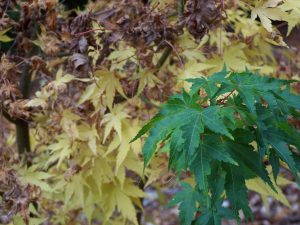
The second step begins when night temperatures cool to near freezing, which is not a predictable date. Because many of the biochemical and physiological processes have already begun or are finished, the response to cold night temperatures is rapid and visible. Leaf colors change as the plant begins breaking down leaf materials for mobilization and storage elsewhere in preparation for winter dormancy.
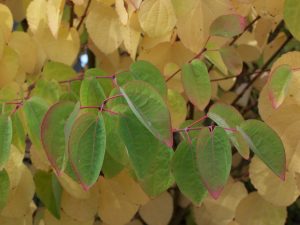
This process, honed over millions of years, is unfortunately not infallible especially under abnormal environmental conditions. Two examples spring to mind:
- High intensity street lights. If the normal light-to-dark ratio change is interrupted by significant levels of night light, the first step of dormancy is hijacked. You can see what happens in these previous blog posts here and here.
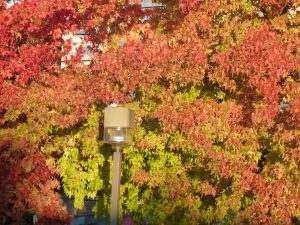
- Unseasonably cold weather. With climate change, we are seeing wild shifts in all sorts of weather patterns, including the date of the first hard freeze. Hard, early freezes are not the same as a light evening frost. You can see what happens here:
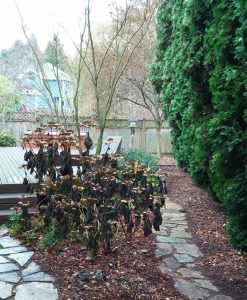
Given normal conditions, however, temperate trees and shrubs are well on their way to full winter dormancy by late summer and early fall. Pruning them is not going to induce new growth.
You are so in tune with us in the field…I was wondering about this…today.
There’s been some DARN cold weather moving in from the north, hasn’t there?
Yes…the precipitous swings in temperatures such as in the Midwest are quite alarming.
Your discussion of late summer pruning was exquisitely clear, Linda.
The photos and their captions added valuable depth to the blog.
Thank you!
Thanks, Carol! Glad it is helpful!
Will pruning at this time remove any resources the plant may need before spring pruning? “Excess resources are routed to woody parts of the plant for storage.” Thanks, Brandon
If you prune in the summer, yes. There will be fewer stored resources.
Good information; thank you!
Define late summer pruning
There is no definition. It’s well after the longest day in the year when plants are already getting ready for winter dormancy. If your plant isn’t sending out new growth on its own at that time, it’s not going to when you prune it.
Dear Professor Linda,
I live in a tropical region and would love to know if there are “more” to pruning tropical woody plants, especially roses?
From this blog, do I understand it correctly that I can prune my roses at any time regardless of whether it is summer or winter (we do not have autumn nor spring here, unfortunately).
Are all rules still applicable to roses in tropical regions except that they do not have winter dormancy?
You’re in luck. Pruning reponses of woody plants are pretty much uniform. If you prune something (like many roses) that do not have winter dormancy, they will regrow IF everything else is optimal (sufficient water, sunlight, etc.). Plants that experience some sort of genetically controlled dormancy (winter dormancy is most common), then they will not regrow until their internal clock allows them to do so.